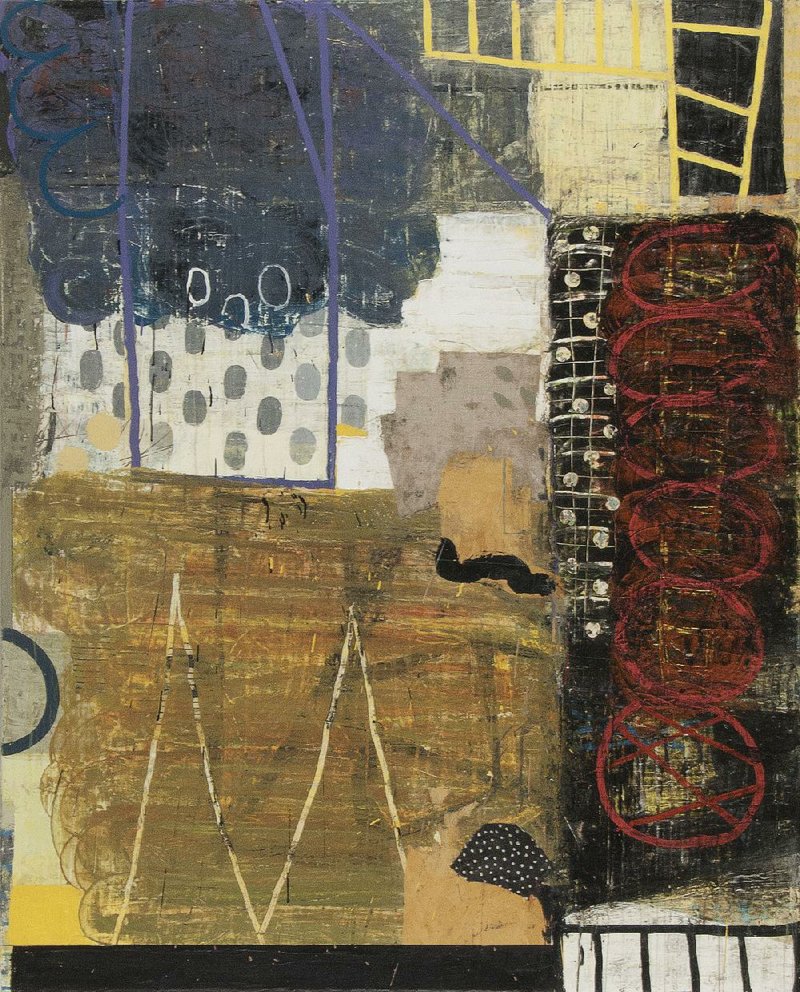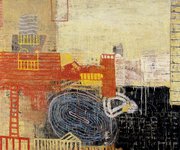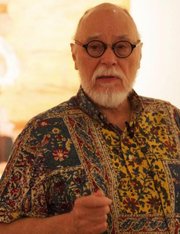"Painting ... always painting."
Those three words appear at the top of each page of painter Sammy Peters' website.
“Sammy Peters:
Then and Now”
Through Aug. 26, Butler Center for Arkansas Studies, 401 President Clinton Ave., Little Rock
Hours: 9 a.m.-6 p.m. Monday-Saturday
Info: www.butlercenter.org, (501) 320-5790
“Southern Abstraction”
Through Aug. 12, Greg Thompson Fine Art, 429 Main St., second floor, North Little Rock
Works by Sammy Peters (including a mini-show in the viewing room), Pinkney Herbert, Robyn Horn, Dolores Justus, more
Hours: 10 a.m.-5 p.m. Tuesday-Friday, 11 a.m.-4 p.m. Saturday
Info: gregthompsonfineart…, (501) 664-2787
It's a mantra, of sorts; maybe a motto; perhaps a guide to life or a work ethic; words that just might reveal something about who Peters is.
The desire to paint "is there pretty much all of the time," he says. "I want to do something that is positive in the work. I'm a better husband and father when I paint. It feeds into my life, causes my mind to be in a good place.
"I believe in positive things and I want to do something positive in the work. I feel I'm doing something for the planet. Whether I am or not, I have that sensation that draws me back to painting."
Three other words, along with a couple of punctuation marks, provide a template of sorts for the koan-esque titles of most of his abstract artwork since about 1995. For example, there's Observation: presence; revealed, one of the paintings in the superlative exhibition "Sammy Peters: Then and Now" at the Butler Center for Arkansas Studies. The exhibit surveys his work since 1962 and is accompanied by a full-color catalog.
"It was something that came to me; there was no precedent for it," he says. "I needed a title for a work. I tried to be creative, but all of a sudden I didn't want the title to be specific. The words that resonate with me reflect my personality to me; maybe not to someone else. Like paintings, I have no idea how people will react. The titles are more about me than that particular work.
"I didn't want to corral a painting, make it this and not that."
It has been nine years since the gentle, soft-spoken Peters has had a solo exhibition of his often large canvases in his hometown. So it's only fitting that the Little Rock artist's abstract multimedia paintings get not one, but two showcases.
"Then and Now" is a career survey organized by Peters and Greg Thompson of Greg Thompson Fine Art. The show hangs through Aug. 26 at the Butler Center. Thompson also is presenting Peters' works in a mini-show that is part of the "Southern Abstraction" exhibition at the North Little Rock gallery through Aug. 12.
It's a lot of visibility for the artist, whose last solo Little Rock show was in 2008 at the now-closed Heights Gallery.
Still, it's not like Peters has been flying under the radar since then.
He and good friends/fellow artists David Bailin and Warren Criswell have shown their work together, at Arkansas State University in 2014 and at the Butler Center in 2015, under the title "Disparate Acts." Peters had a solo exhibit at Arkansas Tech University in 2014 and solo exhibitions since 2000 in Santa Fe, N.M., and Atlanta, Houston, Memphis, Phoenix and Scottsdale, Ariz.
Their friendship -- the men meet weekly for lunch, sometimes joined by other artists -- doesn't manifest in his art.
"We're on autopilot in a different galaxy," Peters says, laughing. "There's an electricity exchange in our discussions about art, what we like and don't like. David and Warren are better at art history; Warren knows more about literature than David or I. Warren's also written about my work, which was very helpful to me in understanding what I do as an artist. David's just written something about my titles, and I'm looking forward to reading it."
Thompson, who met Peters 20 years ago as he began his career as an art broker and later a gallery owner, holds Peters in high regard personally and professionally.
"He has a Buddha-like calmness with a dry, intelligent sense of humor and perspective," Thompson says.
Peters, he says, is "an international artist."
"I put Sammy up there with Willem de Kooning and Jackson Pollock. I think he's one of the most important artists to come out of Arkansas ... out of the South ... along with Carroll Cloar, Robyn Horn. There is a timeless resonance to Sammy's work, there is depth and an almost Eastern sensibility I connect with."
"Then and Now" had earlier stops in Fort Smith and Memphis in 2016. Each iteration of the touring exhibit has been a little different.
"The content that changes is in the 'now' part," Peters says. "When my show in Santa Fe closed this spring, I added some of those works into the mix."
Peters sees himself as influenced by early abstract expressionists such as Pollock, de Kooning and Franz Kline.
"The drama in their work was a little overblown," Peters says. "My work is quite a bit different. When it comes to art, the viewer and the artist dance together. The viewers can have their reading, whatever causes them to fall in love with it. But it's not necessarily the same feeling the artist feels when he finishes it. Sometimes I'm exhilarated when I finish a work, other times I'm just glad it got finished."
...
Sam and Juran Peters moved their family to Little Rock from Shreveport when Sammy was 6 years old.
"I grew up in a household with a lot of art. My father was an artist and a sign painter who owned Ace Signs in Little Rock; dad was very encouraging about my pursuing art. He's the main influence."
Others made an impact as well: Little Rock Central High School art teacher Helen Terry Marshall, Arkansas painter Edwin Brewer and high school friend and painter Patrick McFarlin.
"It was very eye-opening; Helen Terry Marshall brought in films about abstract expressionists and others into our classroom. She took us on art trips to the Memphis College of Art."
Brewer was a highly regarded artist, as were his father, Adrian, and grandfather Nicholas. Edwin Brewer taught at the Arkansas Arts Center and Little Rock University (now the University of Arkansas at Little Rock) in the 1950s and '60s. Peters and his father painted with the Brewers on occasion in Edwin Brewer's studio behind his home in the Hillcrest neighborhood.
"Edwin was a mentor to me," Peters says.
McFarlin and Peters got better acquainted in college and later shared a painting studio. In the early '60s, Peters knew his direction was in abstraction. McFarlin became a figurative painter and has had a studio in Santa Fe some three decades.
One of the more fascinating turns in Peters' life came when he and McFarlin moved to the Berkeley, Calif., area around 1964 at the invitation of McFarlin's cousin.
"I had studied drama at the Arkansas Arts Center and I thought I might like filmmaking and directing," Peters says. While acting in a play in Berkeley, he was introduced to a member of the San Francisco Mime Troupe.
"I was an assistant director on some of their projects; they did plays, too, such as Waiting for Godot."
The manager of the Mime Troupe was Bill Graham, the rock impresario whose Fillmore club became a hotbed of '60s psychedelic rock; he worked with bands such as Big Brother and the Holding Company (with Janis Joplin), the Grateful Dead and Jefferson Airplane.
Peters was engaged to work on posters for Graham's activities, but Peters was missing his family in Arkansas and decided to move home. McFarlin stayed for a time before returning to Arkansas, then on to Santa Fe.
The posters for Graham's shows became icons of '60s psychedelia.
No regrets, Peters says.
...
All these experiences, and many others, including his 40-plus years marriage to Pam, have brought Peters and his art to this point. And it's all there on the walls of the Butler Center and Thompson galleries. Clearly, he has dedicated his life and career to abstraction and its possibilities. Peters has been faithful to that vision. His open approach to creativity gives his vision an uncommon depth artistically, technically and emotionally.
Through his use of a diverse and sometimes almost clashing palette, drips, over- and under-painting, scraping, splatters, collage and more, Peters finds freedom to express what he sees, believes and feels.
"Painting is like breathing, it's a heartbeat," he says. "When I'm in the studio, I'll see what's happening in the stages of evolution in the two or three works I've got going. Maybe I'll see something I haven't noticed before and use that as a departure to start another painting.
"I like a divided canvas, I like edges, where one thing leads to another and might go over to the other side of that canvas. I like the surprises that emerge. As I'm working, it's a little bit like the surrealists. They would do autonomic [spontaneous] drawing. Let one thing lead to another. That intrigues me, as does the collective consciousness, which is part of what I do. When I go to sleep at night or if I'm in a quiet place, I can key in a thought of a dream, which will lead me to a more expansive vision. That place leads to another place. It's a bit like conscious dreaming."
Peters' sophisticated compositions are fluid, with an undeniable sense of movement, a striking intelligence and a rhythm born in the artist's heart and mind and expressed through his skillful hand. There are threads of thought, place and direction a viewer can follow through the various vertical and horizontal elements he employs. As large as some of his canvases are, they seem like a world the viewer can physically enter.
More recent paintings have an occasional, fascinating sparseness that suggests meditative or metaphysical aspects; perhaps a sense of urgency or maybe reflection brought on by the passage of time and experience.
Throughout, the paintings of Sammy Peters reveal a restless spirit, an intuitive artist who isn't afraid to go forth boldly and unpredictably; he is an artist who is still hungry, still wanting to break new ground.
And the surprises have emerged steadily over six decades, as "Sammy Peters: Then and Now" and his work in "Southern Abstraction" make abundantly clear. They likely will continue to do so.
"Painting ... always painting."
Email:
ewidner@arkansasonline.com
Style on 07/09/2017



